New consumer study shows that the EV transition is inevitable
New Study
European consumers want electric vehicles
The Platform for electromobility – representing more than 45 organisations from industry, civil society and cities, and across all transport modes – released a report carried out by Element Energy on consumer’s perception on the shift to electric vehicles (EV). The study, which surveyed 14,000 new car buyers across Europe shows that consumers are ready to move to electric.
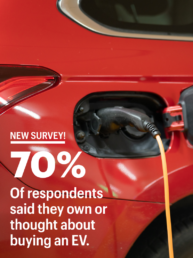
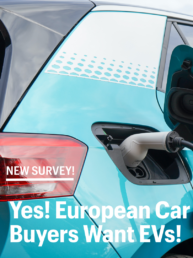

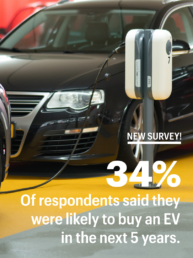
Our policy recommendations
Significantly strengthen CO2 standards for passenger cars and vans targets
The importance of upfront cost in unlocking massive EV uptake highlights the need for ambitious regulation on CO2 Standards for cars and vans to ensure production scale up during the 2020s. An ambitious legislation will increase the offer and promote the market uptake of zero-emission vehicles. With an increased market, zero-emissions vehicles will also become more affordable at purchase price with a continuously reduced total cost of ownership and more choice for consumers and will also help tackle air quality and noise issues, bringing an overall benefit to society. As detailed above, the study confirms the feasibility of new proposed interim targets will be met by strong consumer demand.
Under the CO2 standards for passenger cars and vans, introduce a new provision to electrify corporate fleets
The study demonstrates the importance of corporate fleets in driving markets for electric vehicles. The Platform for electromobility therefore proposes to mandate the decarbonisation of corporate cars by 2030. In a previous communication, the group outlined the environmental and social benefits which such an EU-level mandate could bring. One major motive is for the EU to act quickly and decisively electrify a segment representing over 60% of vehicles sales in Europe and subsequently create a sufficient second-hand market by 2035 as most private consumers use this channel. To enshrine electrification objectives for corporate fleets in EU law, the Platform support the proposition by Rapporteur Huitema to revise the Clean Vehicles Directive (CVD). Its scope could be extended to corporate fleets as part of the revision of the CO2 Standards for cars and vans Regulation.
Do not introduce fuel crediting in the CO2 standards for passenger cars and vans
The study shows e-fuels as a dead-end solution for consumers. Even at a seemingly unreachable price parity with BEVs, consumers would still opt for the electric option. The Platform is opposed to introduction of a fuel crediting mechanism that would consider the contribution of renewable and low carbon fuels in the compliance assessment for each manufacturer. Policies focused on decarbonising fuels and those focused on reducing emissions from cars and vans must remain in separate legal instruments.
Under the Alternative Fuels Infrastructure Regulation, we need more ambitious targets for EV uptake
The Platform for electromobility believes the Commission’s AFIR proposal is a good start but, to ensure charging points keep up with the EV uptake, the level of ambition of the mandatory targets for light-duty vehicles must be doubled. For long distance journeys, the targets for the TEN-T comprehensive network should be brought forward to 2025.
The Energy Performance of Buildings Directive should facilitate the access to private charging
The revision of EPBD must ensure the right-to-plug to all EV users in order to facilitate the installation of charging infrastructure for tenants and properties under shared ownership. Drivers willing to make the transformation often face diverse obstacles: latency between requesting a charger and installation, installation of charging infrastructure for tenants and properties under shared ownership, lack of electrical pre-equipment in collective electrical installations etc. Smart charging is also required in all types of buildings as it provides benefits to both the power sector and the EV users. The revision of the Energy Performance of Buildings Directive is therefore very timely to address those challenges and ensure a minimum level of charging points in all off-street parking lots.
Launch event: "Are consumers ready for electric vehicles?"
The Platform for electromobility is pleased to organize the first ever presentation of the study ‘Are consumers ready for electric vehicles?’
The study undertaken by Element Energy and the Platform for electromobility is the largest consumer choice study ever conducted in the mobility sector and aimed to understand consumer preferences in the mobility transitions and how these could change in the future. This event will launch the public presentation of the results.
The European mobility transition will not happen without the Europeans. With the Fit for 55 Package for discussion on the table, it is now more crucial than ever to understand whether the transition to electromobility is inevitable or not?
With a special message from Commissioner Didier Reynders
Date & Time
12th January 2020
13:00 - 14:30
Online
Moderation
Event moderated by Katrina Sichel
Program
Keynote speech
Didier Reynerds, Commissioner
Presentation of study
Celine Cluzel, Element Energy
Panel discussion
Monique Goyens, BEUC
Daniel Mes, Cabinet EVP Timmermans
Amélie Pans, Chair of the Platform for electromobility
Celine Cluzel, Element Energy
Closing Speech
MEP Caroline Nagtegaal
Contact
Théo Fievet
Coordinator
theo@platformelectromobility.eu
+32 4 78 70 05 48
Platform’s reaction paper to the proposal for the revision of the Renewable Energy Directive
Renewable energy:
Our position on the revision of the directive
The Platform for Electromobility welcomes the timely revision of the Commission’s proposal for the RED (Renewable Energy Directive). This will be key in supporting the EU in reaching carbon neutrality, notably by advancing the case for an electrified, decarbonised and efficient transport sector. In fact, clean direct electrification is the most cost-effective way of decarbonising Europe and reaching the 2030 and 2050 climate targets.
Moreover, direct electrification of transport has accelerated in recent past years, and the pace is only expected to increase. According to a recent BNEF study, in order to reach 100% CO2 emissions reduction by 2035, some 67% of passenger cars sales in Europe will need to be electric by 2030.
This rapid, massive uptake of EVs has the potential to become – thanks to smart charging – a flexible asset for grid management and an opportunity for prosumer business models. It will also provide a boost to the increased and cost-effective penetration of renewable energy in the electricity system. The combination of EVs, their batteries and smart charging functionalities as sources of ancillary services for the distribution grid will clearly bring benefits in terms of RES (Renewable Energy Sources) integration. Electromobility and renewable energy therefore offer a win-win partnership.
In this context, the Platform welcomes the recognition of smart charging and, where appropriate, bidirectional charging for integrating transport in the energy system. Two aspects in particular stand out; 1) the relevance of the charging points located at long-time-parking spaces, and 2) that national regulatory frameworks do not discriminate against electric vehicles participating in the electricity markets.
However, we do believe there are certain key aspects that can still be further reinforced within the Commission proposal. These will help support EV uptake and lead to swifter decarbonisation of both the transport and energy sectors

Greenhouse Gas based mandate
The Platform for electromobility raises concerns over the shift from an energy-based target for transport to a greenhouse gas (GHG) metric. If we support the fact that a threshold expressed in terms of GHG provides a relevant tool for accelerating the decarbonisation of transport while guaranteeing technology neutrality among low-carbon technologies, it may – within the framework of the RED – add complexity to the metric. Furthermore, it does not seem to bring any genuine added value to boosting renewable energy when compared to the existing framework. In fact, multipliers are implicitly integrated in the GHG-emission calculation method, and the GHG-emission based target of 13% is equal to the 24-26% in final energy consumption considered by the European Commission in its public consultation.
Furthermore, given that currently 24 of 27 Member States implement an energy-based target, it should be noted that using such a metric will have an impact on the current implementation of the Directive; these countries will have to start from scratch again, having just finished transposing the current RED II. This could result in delays in meeting the RES-T target and the overall EU binding RES target. France, for example, is currently working on the implementation of its credit mechanism, aimed to have this enter into force by 2022 using an energy-based RES-T target. With the switch to an emission-based target, France would have to revise its credit mechanism almost immediately following its implementation, leading to further delays.
Platform Members therefore invite the Commission to provide further information on its motive and rationale behind introducing a new GHG emission-based transport target.
Inclusion of electricity in national compliance mechanisms
The Platform is pleased that the proposal levels the playing field between biofuels and electricity by including electricity in national credit systems for fuel supplier compliance. This is a feature of the Directive that we called for in an earlier communication. The proposal shall as well ensure level playing fields between zero emissions options, especially between electricity for BEVs and RFNBOs . For instance, hydrogen can claim credits for private charging while renewable electricity for electric vehicles is restricted to public recharging stations only.
Focusing specifically on ‘public’ recharging points is discriminatory and inefficient. This is because it excludes some 80% of electricity supplied to road vehicles and provides incentives for people to charge their cars at public charging points rather than at home, as well as for companies not to charge their trucks and buses at their depots. The scope of the electricity credit mechanism should therefore be expanded to include recharging stations more generally, encompassing both public and private ones. It should also be possible for such a credit mechanism to also be applied to other types of transport such as rail, aviation or shipping.
The text is unclear as to whether it would apply to charge point operators (CPOs) alone, or whether it would also apply to electricity suppliers. Within the current proposal, this could lead to a situation with different incentive schemes resulting in confusion amongst actors and the relevant incentive schemes.
Permitting
The Platform supports the Commission’s proposal to tackle the remaining barriers, including those relating to permitting procedures. We welcome in particular the proposed publication of a guidance on best practices to accelerate the permitting of projects. We urge the European Commission to publish such a guidance swiftly and ensure the best practices are disseminated to local authorities. Nevertheless, the review of permitting administrative procedures must be urgently addressed in the short term in the RED III and not be left until 2024. This will be key to preventing bottlenecks that may hinder the achievement of national RES commitments and the deployment of renewable installations more generally. We also recall that this should be done in cooperation with grid operators in order to preserve the security/stability of the grid.
Coherence with the Alternative Fuels Infrastructure Regulation (AFIR) and the upcoming revision of the Energy Performance of Buildings Directive (EPBD)
The Platform calls for ensuring the consistency of the RED III with the new Regulation on the deployment of alternative fuels infrastructure. The current definition on smart charging and bidirectional recharging should be aligned and any change to the related definitions and provisions in one text should be made in the other.
Furthermore, given that the European Commission has integrated provisions on the private charging points regarding smart charging in the RED III, we would like to underline the necessity of ensuring their coherence with the upcoming revision of the EPBD, which addresses private charging in its Article 8.
Coherence with Battery Regulation
On the data-sharing requirements relating to batteries, the Platform recommends ensuring consistency with proposed requirements under the EU Battery Regulation proposal and avoiding any duplication. For example, new performance and durability requirements for batteries are already included in Article 10 of the Battery Regulation proposal.[1] Similarly, the information on the state of health of the battery is included in Article 14 of the proposal.[2]
[1] The UNECE has recently developed performance and durability requirements via GTR, and therefore may be directly applied by the EU.
[2]This is also regulated by UNECE GTR on in-vehicle battery durability, namely ‘State of Certified Energy’ (SOCE), or capacity fading, and ‘State of Certified Range’ (SOCR).
Zoom in on the deployment of charging infrastructure in France
Zoom in
the deployment of charging infrastructure in France
The French government set ambitious objectives for the deployment of charging stations to deploy 100,000 charging points (CPs) by the end of 2021 and to equip all service areas on the highways with fast charging stations by 2023.
To know where to go, we need to understand where we are. This is why, UFE has launched two mapping tools, updated every 3 months, that aim to follow the state of deployment of the public CPs in France.
- Mapping 1 reflects the deployment of publicly accessible charging infrastructure in the French regions and departments since September 2020.
- Mapping 2 shows the (ultra-) fast CPs on the French conceded highway network since March 2021.
Methodology[1]
Mapping 1 indicates the number of EVs available for 1 CP per region and department, with reference to the ratio of 1 CP per 10 EVs set by the current Alternative Fuels Infrastructure Directive (2014/94/EU). Mapping 2 assesses the equipment rate of the service stations in at least 50-kVA CPs for all motorways operated under a concession.
Where does France stand at the end of September?
France has acquired around 46,300 CPs and 660,000 electric vehicles in circulation since 2010. Over the past year of monitoring the CPs’ deployment in regions and departments, the number of CPs has increased by 42%, while the EV fleet has grown by 78%. Even if the number of CPs keeps increasing gradually every 3 months, the threshold of 1 per 10 has been exceeded in all regions except Occitanie.
As for CPs on the highway network, (ultra-) fast charging has increased by 9% in France since June 2021 or by 42% in 6 months. 55% of the highways were equipped with at least one fast CP equal to or greater than the 50kVA.
Conclusion
UFE’s mappings show that, while the country is on the right track, more efforts are needed to reach the objectives set by the government for the deployment of public CPs in regions and departments. In this respect, the new AFIR could give France the final boost it needs with the right targets.
[1] AAA Data’s (electric vehicles) and Gireve’s (charging points) figures for UFE
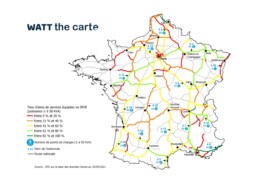
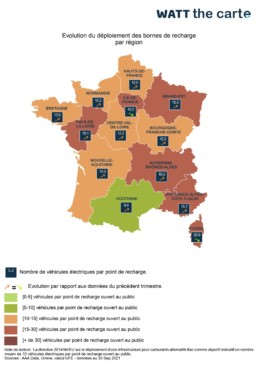
General internal information
Contact list here (contact secretariat for first access)
Plenary meetings
Studies
Outreach meetings















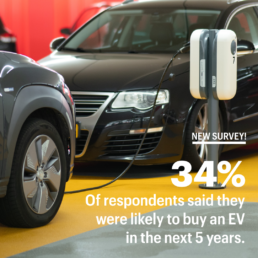
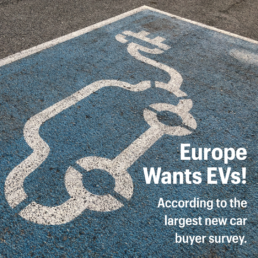
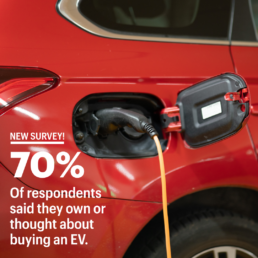
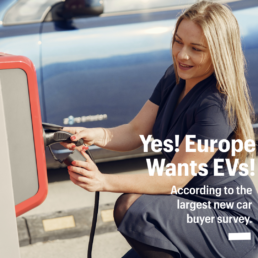
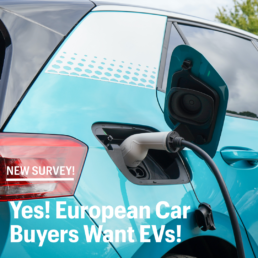
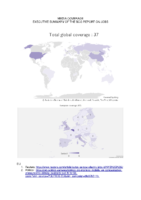





![20211022_ECF_Results Presentation[14] 20211022_ECF_Results Presentation[14]](https://www.platformelectromobility.eu/wp-content/uploads/_pda/2021/12/20211022_ECF_Results-Presentation14-thumb.png)